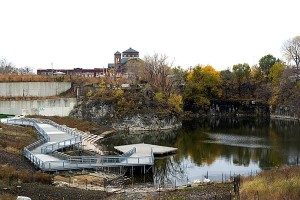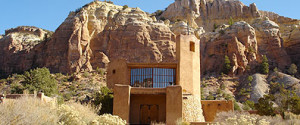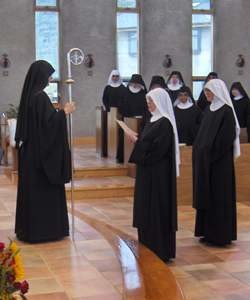Our community began life living according to the charism of the Community of Jerusalem. This new religious order began in Paris and spread to many major European cities and to Montreal. We were going to be their foundation in Chicago, and in a filial sense we were. When the brothers arrived in Chicago in 1991, however, there were canonical obstacles in the way of an official affiliation.

Palmisano Park and Saint Barbara’s parish in Bridgeport. It looks a lot nicer in the summer! For a terrific gallery, click on the photo.
This meant that our continued existence depended upon the local Archbishop. Cardinal Bernadin had invited us, and was a strong supporter of our work, but by the mid-90’s, he was experiencing serious health problems, including the cancer that would eventually claim his life in 1997. So we were looking for a way to strengthen our community canonically, perhaps by affiliating with a different monastic community. Another factor in this discernment process was the strain of translating what was then a _very_ French, even Parisian, religious ideal into the blue-collar, multi-ethnic, South Side Chicago neighborhood of Bridgeport. These were the days before Bridgeport became the new Bohemia (or for locals, the new Wicker Park/new Pilsen…), but even now, I don’t see the Jerusalem model working here.
We began looking for something more stable and at the same more flexible. The idea of becoming Benedictine had been tossed around, but most of the Benedictine communities we knew were operating schools or involved in other active ministries. Our mission from the Cardinal was to be contemplative. One of the monks went on retreat to Christ in the Desert in New Mexico, and there learned that they had recently entered into a congregation of Benedictines that was more oriented toward contemplation. Formerly known as the Cassinese Congregation of the Primitive Observance, in 1997 the newly-christened “Subiaco Congregation” numbered nearly seventy communities, spread over six continents.
Christ in the Desert has its own very interesting history, which you can read about here. Make no mistake, this is a place of contemplation. Fourteen miles down a gravel road into the Chama canyon, it’s pristinely quiet and just rustic enough to keep you alert (e.g. rattlesnakes). The community there very generously offered to adopt us city boys as a dependent house, if we so chose. After consultation with Cardinal Bernadin, who enthusiastically supported the change, we entered into the Benedictine family.
During one of the abbot’s first visits, he got rid of the community money box and pointed out that we needed to pray the office of Vigils. We began to visit there more frequently, often returning with new ideas. We noted how traditional practices like statio (brothers lining up in ‘battle rank’ and processing into the choir) and penances for latecomers at the liturgy helped to create an atmosphere of recollection and purpose. We also discovered that once we would adopt a new practice from the Rule, we would begin to see how it connected to other practices in the Rule. Many disciplines that seemed silly or outdated when we began, gradually came into focus, and the wisdom of the Rule understood as a whole, and within the larger monastic tradition, began to invigorate us. We became evangelists for Saint Benedict’s monastic vision.
There were two other significant events in this movement toward a stronger, more integral observance of the Rule.
First was another article in Worship magazine, this one by Monsignor Francis Mannion. The article discussed the blessings for brothers leaving and returning to the cloister. These are minor exorcisms. This being the case, use of these blessing generates a certain disposition of the monk toward the world. It is not hostile, mind you. But it is cautious and realistic about the importance of the discipline of silence and withdrawal for the monk or nun. We live in a bustling city with many potential dangers to one’s spiritual health, especially for those who cultivate a contemplative openness to God’s quiet communication through His creatures. So we began to use the blessings.
Secondly, we struck up a friendship with the nuns at St. Walburga’s Abbey in Virginia Dale, Colorado. We used to go there regularly on community retreats as a way to experience a bit of distance from the city. They are another contemplative community, and even have a mitered abbess (meaning, among other things, she has the canonical right to carry a crozier and to preach). It was there that the idea of doing all 150 Psalms in a week took shape in our minds. We had felt that the peculiar circumstance of the city required us to have less Psalmody and more silence, but the sisters’ example worked away at us. There was something about their joyful, matter-of-fact acceptance of the requirements of the Rule that moved us deeply. We began chanting the full Psalter in the year 2001, and once more, the immediate effect was that many other aspects of the liturgical code of the Rule suddenly made sense. They seemed rational.
Now I recount all this because it is parallel to our experience with the larger tradition of the liturgy. Our typical experience tends to narrow of thinking about the liturgy to: 1) the Mass; 2) Tridentine vs. Novus Ordo; and 3) political leanings of those who favor one of the two options. But the liturgy is celebrated by all Christians, and has been for two millennia. It includes the whole panoply of the Mass, Divine Office, Processions and Litanies, blessings of persons and holy items, and all the accoutrements that go with: vestments, buildings, music and so on. Once we began to discover the ancient Benedictine rite of the Divine Office, for example, other aspects of the liturgy seemed less odd, less tied to contemporary political positions, more laden with potential for spiritual growth, more full of joy. This is the broader background of our use of the ad orientem posture at Mass. There is a whole world of thought that created the liturgy under the influence of the Holy Spirit, and working our way back into this stream of life brought insight into theology and prayer that we had not obtained through newer, more locally restricted practices.
The more we discovered, the more we hungered for discovery in the Church’s broad experience of the Kingdom of God, inbreaking in the the Divine Liturgy, to which we will return in the next post.

